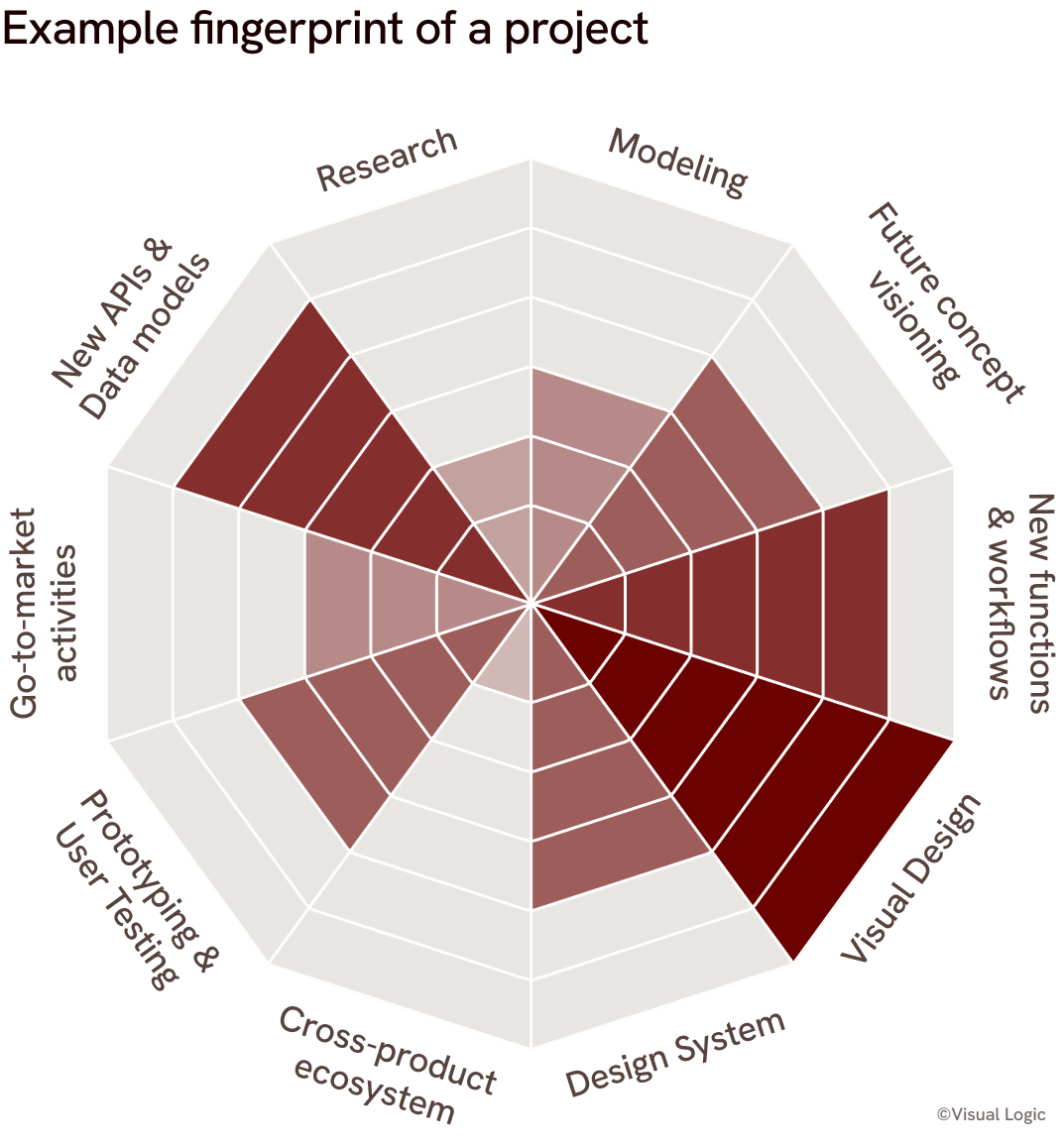
The Fingerprint of a Project: Why Great UX Looks Different on Every Project
The problem: UX professionals often feel frustrated when they can’t “do the job right”—when research gets cut, modeling is rushed, or strategic vision is sidelined. But chasing a perfect process on every project isn’t just unrealistic—it can be harmful.
Key takeaways:
- Every project has a unique “fingerprint”—a mix of constraints, context, and appetite that defines what’s possible.
- Pushing for perfect UX practices in every category can damage both the project and the designer.
- Strategic designers learn to read the fingerprint early, adjust expectations, and push just enough in the right areas.
- The fingerprint can change over time—and across project types—even within the same organization.
- Recognizing the fingerprint leads to healthier teams, smarter influence, and better outcomes.
🎧 Listen to the Humans First episode to hear the whole conversation.
Why UX frustration often comes from the wrong expectations
Designers are wired for excellence. We want to get it right. That often means striving for excellence across the board: deep user research, thoughtful modeling, clear frameworks, layered design, testing, iteration. In an ideal world, all of those bars are at 100%.
But here’s the catch: no project is the ideal.
Budgets are limited. Deadlines loom. Internal stakeholders have differing priorities. The business has specific urgency. These factors shape what’s possible before we even show up.
And pushing for a perfect process anyway? That usually becomes a recipe for disappointment, friction, and fatigue.
What if instead of forcing every project to conform to an ideal design process, we recognized each project’s unique fingerprint—and adapted our craft accordingly?
What is the fingerprint of a project?
Every project has a unique shape—a blend of constraints, expectations, and appetite that define what’s possible. We call this its fingerprint.
You can think of it like a set of sliders, each representing a different area of effort. And not just UX activities like research or wireframes—but the full spectrum of what makes a product move forward:
- How much research is realistic?
- How much modeling or system thinking will be accepted?
- How open is the team to introducing new design patterns?
- How much change can the engineering team absorb in this cycle?
- How urgent is the go-to-market timeline?
- How formal does stakeholder communication need to be?
- How locked-in is the business model or product direction?
In a perfect world, every slider would be maxed out. But in reality, the fingerprint of a project might look more like this:

This pattern isn’t a failure—it’s the fingerprint of what’s possible in the current moment. And trying to force every bar to 100%—whether it’s research or platform change or vision setting—doesn’t just create friction. It often leads to burnout, tension, or stalled momentum.
The fingerprint helps you work smarter. Instead of assuming every project should support every process at full volume, you start by asking:
What does this project actually have capacity for—and where should I lean in?
Read more: How long does UX design take?
How do you uncover a project’s fingerprint?
You can’t always identify a project’s fingerprint on day one. In fact, it often reveals itself only through interactions:
- Ask to interview 10 users. Does the team light up… or shut down?
- Try modeling personas or environments. Do stakeholders engage—or move to the next task?
- Are they eager for design vision and paths toward innovation—or just trying to get something out the door?
Each moment offers a signal. Over time, those signals form a clearer picture of the team’s appetite and constraints.
Here are two main characteristics of a project fingerprint to keep in mind as you’re building yours:
- The fingerprint isn’t static—it evolves. Even when you’ve figured it out, it can change. Economic pressures shift. Priorities flip. A company’s budget may shrink mid-project. A leadership change may deprioritize research. A business win might open the door to future investment. Designers who expect the fingerprint to stay fixed get blindsided and frustrated. Designers who assume it will change learn to adapt.
- The fingerprint can differ between projects. Sometimes teams feel like every project needs the same process. Designers expect deep research on a fast-track build; stakeholders demand quick wins from a vision sprint. Everyone feels misaligned. One solution we’ve seen work well is naming the difference. In one organization, we helped define two distinct project modes: fast-track efforts focused on immediate delivery, and long-horizon vision projects aimed at shaping the future. Once those types were clarified, teams could calibrate expectations and effort, and everything became easier to talk about.
Pushing the sliders: working within a project’s fingerprint doesn’t mean settling for less
Trying to push every slider to 100% isn’t just unrealistic—it’s unsustainable. It creates conflict with stakeholders and internal dissatisfaction for the designer. You risk burning out, or worse, being viewed as inflexible and out of touch.
At the same time, not pushing to 100% can feel like settling for less. We combat that feeling by taking a posture of empathy + influence.
Accept that every project has limits. But also recognize where you can gently raise the bar. Even getting research from 30% to 40% is a win. Over time, those small pushes compound. Trust is built. Maturity is raised.
The lesson here? Strategic designers aren’t perfectionists. They’re pattern readers and lever pullers.
Dive deeper: What else adds to an organization’s design maturity?
How far should you push? And when should you stop?
Once you understand a project’s fingerprint, the next challenge is knowing what to do with it. You might see the opportunity to elevate a piece of the process—add a bit more research, introduce a new pattern, advocate for a better rollout plan.
But how far do you push? Push too hard, and you create friction or erode trust. Push too little, and you miss a chance to move the team forward.
This is where strategy meets intuition. Here’s how we think about it:
- Push where it matters. Not every slider needs to go up. Choose the ones that will create the most impact—and the most momentum.
- Look for levers, not walls. If a team resists because of timelines or budget, that’s a wall. If they resist out of habit, uncertainty, or internal politics, that’s a lever. Push the levers.
- Watch the signals. The team’s reactions—whether they light up or shut down—will tell you how far to go. Do they immediately question the value of a user interview? Do they perk up at concept visioning? And when a stakeholder pulls you aside and says, “I’m waking up in cold sweats because contracts are signed and we don’t have a product yet,” (yes, we’ve had this exact phone call) that’s your cue to stop advocating for depth and start helping them ship.
- Adapt when things shift. Priorities will change. Budgets get cut. Leadership moves on. This can feel like a regression, but recognizing that change is part of the fingerprint model helps you stay grounded. The fingerprint will evolve—and your approach should too.
The fingerprint is a tool for healthier teams
At its core, the fingerprint model is a tool for better mental health—for designers and teams.
It invites reflection:
- Am I holding every project to the standard of an ideal process?
- Where is that causing tension with stakeholders?
- Could I deliver value by doing 60% of the process with excellence—rather than chasing a perfect 100% that’s not realistic?
It also empowers change:
- Can I nudge the team from 30% to 40% on modeling?
- Can I find a better time to introduce vision work or system thinking?
- Can I push in the right places—and rest in the rest?
Designers are naturally optimistic. We believe in better outcomes, more thoughtful solutions, more human products. And you don’t have to compromise your values to adapt to a project.
You can still deliver excellent design, and know that excellence looks different depending on the environment. The more empathy you have for a project, team, and organization, the more power you have to shape what’s next.





